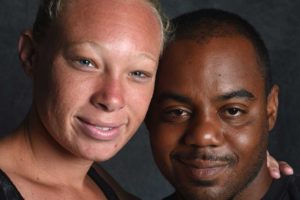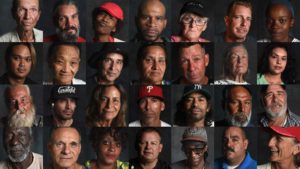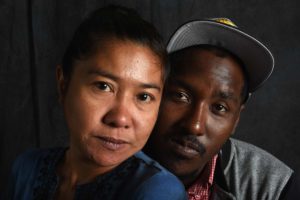Poverty is a Story About Us, Not Them
Too often still, we think we know what poverty looks like.
It’s the way we’ve been taught, the images we’ve been force-fed for decades.
The chronically homeless.
The undocumented immigrant.
The urban poor, usually personified as a woman of color, the “welfare queen” politicians still too often reference.
But as income inequality rises to record levels in the United States, even in the midst of a record economic expansion, those familiar images are outdated, hurtful, and counterproductive to focusing attention on solutions and building ladders of opportunity.
Today’s faces of income inequality and lack of opportunity look like, well… all of us.
It’s Anna Landre, a disabled Georgetown University student fighting to keep health benefits that allow her the freedom to live her life.
It’s Tiffanie Standard, a mentor for young women of color in Philadelphia who want to be tech entrepreneurs — but who must work multiple jobs to stay afloat.
It’s Sharon Penner, an artisan in rural Georgia, who worries about retirement security and health care options for senior gay women.
It’s Charles Oldstein, a U.S. Air Force veteran in New Orleans who would still be on the street if the city hadn’t landed a zero tolerance policy for homelessness among veterans.
It’s Ken Outlaw, a welder in rural North Carolina whose dream of going back to school at a local community college was dashed by Hurricane Florence — just one of the extreme weather events that have tipped the balance for struggling Americans across the nation.
It’s Danielle Atkinson, director of Mothering Justice, a Michigan-based advocacy organization, who’s heard the stereotypes and code words for way too long.
If these are the central characters of our story about poverty, what layers of perceptions, myths, and realities must we unearth to find meaningful solutions and support?

“A lot people can’t tell that we’re homeless, only because we keep clean clothes and we go places where we can clean our clothes and we shower on a daily basis.” — Mary Ellen & Deshaun. Photography courtesy of David Blumenkrantz and the One of Us project.
In pursuit of revealing this complicated reality, Mothering Justice, led by women of color, went last year to the state capital in Lansing, Michigan, to lobby on issues that affect working mothers.
One of the Mothering Justice organizers went to the office of a state representative to talk about the lack of affordable childcare — the vestiges of a system that expected mothers to stay home with their children while their husbands worked.
A legislative staffer dismissed the activist’s concerns, telling her “my husband took care of that — I stayed home.”
That comment, says Atkinson, “was meant to shame” and relied on the familiar trope that a woman of color concerned about income inequality and programs that promote mobility must by definition be a single mom, probably with multiple kids.
In this case, Mothering Justice activist happened to be married. And in most cases in the America of 2019, the images that come to mind when we hear the words poverty or income inequality fail miserably in reflecting a complicated reality: poverty touches virtually all of us.
The face of income inequality, for all but a very few of us, is the one we each see in the mirror.
How many of us are poor in the U.S.? It depends on who you ask.
According to the Census Bureau, 38 million people in the U.S. are living below the official poverty thresholds (currently $20,231 for a family of three with two children). Taking into account economic need beyond that absolute measure, the Institute for Policy Studies found that 140 million people are poor or low-income, living below 200 percent of the Census’s supplemental measure of poverty. That’s almost half the U.S. population.
No matter the measure, within that massive group, poverty is extremely diverse. We know that some people are more affected than others, like children, the elderly, people with disabilities, and people of color.
But the fact that 4 in 10 Americans can’t come up with $400 in an emergency is a commonly cited statistic for good reason: economic instability stretches across race, gender, and geography. It even reaches into the middle classes, as real wages have stagnated for all but the very wealthy and temporary spells of financial instability are not uncommon.
LGBT seniors like Penner, for example, may have worked steadily throughout their lives but now faces hurdles in retirement because of a lack of health care or inclusive senior care facilities.
Yet too many of us still cling to demeaning stereotypes about who poverty impacts, which affects how we live with each other and how we develop policy responses to the income inequality that has defined American life in recent decades.
Simply put, the narrative that Americans tell themselves about poverty is badly flawed.
Pernicious caricatures remain of who is living in poverty as well as what is needed to move out of it. The iconic American myth is that you can pull yourself up by your bootstraps and change a bad situation into a good one. The reality is that finding opportunity without help from families, friends, schools, and community is virtually impossible. And the playing field is nothing close to level.
Take Outlaw, for example. A high school dropout, who went back to school at James Sprunt Community College in Kenansville, NC. His normal day? He got home from a night shift job at 2 a.m. and went to bed. He set an alarm for 6 a.m. to prepare for school. At 7 a.m., he headed to classes and, after the school day, went back to work before arriving home again. “It was a lot, but I’m not afraid of working hard,” he said. “At the time, I was thinking it would all be worth it to create a better life for my family.” That was before Hurricane Florence destroyed his home and put his hopes of furthering his education and career in danger.
The FrameWorks Institute, a research group that focuses on public framing of issues, has studied what props up stereotypes and narratives of poverty in the United Kingdom.
“People view economic success and wellbeing in life as … a product of choice, willpower, drive, grit, and gumption,” says Nat Kendall-Taylor, CEO of FrameWorks. “When we see people who are struggling,” he says, those assumptions “lead us to the perception that people in poverty are lazy, they don’t care, and they haven’t made the right decisions.”
Does this sound familiar? Similar ideas surround poverty in the U.S. And these assumptions wreak havoc on reality. “When people enter into that pattern of thinking,” says Kendall-Taylor, “it’s cognitively comfortable to make sense of issues of poverty in that way. [It] creates a kind of cognitive blindness — all of the factors external to a person’s drive [and] choices that they’ve made become invisible and fade from view.”
Those external factors include the difficulties concomitant with low-wage work or structural discrimination based on race, gender, or ability.
Assumptions get worse when people who are poor use government benefits to help them survive. There is a great tension between “the poor” and those who are receiving what has become a dirty word: “welfare.”
According to the General Social Survey, 71 percent of respondents believe the country is spending too little on “assistance to the poor.” On the other hand, 22 percent think we are spending too little on “welfare”: 37 percent believe we are spending too much.

Photography courtesy of David Blumenkrantz and the One of Us project.
“She used 80 names, 30 addresses, 15 telephone numbers to collect food stamps, Social Security, veterans’ benefits for four nonexistent deceased veteran husbands, as well as welfare,” boomed President Ronald Reagan at a rally in 1976, sharing a favorite campaign anecdote.
One black woman that Reagan termed a “welfare queen” was certainly a con artist — she was also possibly a kidnapper and a murderer — but with Reagan’s words she became even more: a symbol of all black women receiving public assistance, a racist symbol that influenced policy and public opinion for decades.
“Poverty has been interchangeable with people of color — but [specifically] black women and black mothers,” says Atkinson of Mothering Justice. It’s true that black mothers are more affected by poverty than many other groups, yet they are disproportionately the face of poverty. For example, Americans routinely overestimate the share of black recipients of public assistance programs.
In reality, most people will experience some form of financial hardship at some point in their lives. Indeed, people tend to dip in and out of poverty, perhaps due to unexpected obstacles like losing a job, or when hours of a low-wage job fluctuate.
Randy Joiner, another veteran who now has housing because of New Orleans’ pathbreaking program, had worked in construction jobs but then the building boom after Hurricane Katrina began to dwindle and he found himself on the streets.
It follows that most Americans have or will receive some form of help from the government. According to the Center on Budget and Policy Priorities, more than half of Americans received a means-tested benefit (food stamps, Medicaid, cash welfare, disability insurance, or housing assistance) at some point between 1997 and 2017. If one considered the course of a lifetime, that percentage is likely bigger. There are other social programs, too, that assist people by distributing benefits to middle- and upper-income people, like the mortgage-interest tax deduction. As Suzanne Mettler wrote in her recent book, The Government-Citizen Disconnect, “we are all beneficiaries now” of government benefits.
As Mettler told me in a 2018 interview, “[P]eople who view welfare unfavorably think that government is doing something unfair. They think it’s giving special treatment to people who are less deserving,” when they themselves may be struggling to get by.
Those ideas of “deservingness” have seeped into policy. For example, many states prohibit families participating in Temporary Assistance to Needy Families from receiving additional benefits if another child is born while the family is on the program, based on a theory that poor people will have more children to get an extra hundred dollars a month.
Landre, the Georgetown student, struggles with a system of supports for the disabled community that essentially requires poverty in order to receive services.
Nearly 30 years after the Americans with Disabilities Act first outlawed workplace discrimination on the basis of disability, more disabled people live in poverty than when the law was passed. It’s a complex problem with many factors, but in some cases the very program intended to help disabled people becomes a devastating financial trap through Medicaid’s income ceiling.
“People don’t completely understand how backwards and unjust these regulations are,” Landre said. “Every time I talk to someone who isn’t in the disabled community, they’d be like, ‘You’re kidding me. That can’t be how it is, that can’t be the law, there must be a way to fix it.’ ”
And we can fix it. What we need to do is reframe those ideas and shift our thinking.
Kendall-Taylor has some ideas on how to reframe poverty here in the U.S., by reframing our approach to individualism, how other people are different from ourselves, and avoiding unnecessary fatalistic thinking. We actively stigmatize other people, he says, by using “they” and “them” pronouns when talking about poverty instead of “we” and “us.”
Stories in the media tend to focus a lot on describing problems, and a great deal less on possible solutions. Individualism-wise, we need to emphasize “that what surrounds us shapes us,” Kendall-Taylor says — that “the places that we are in, the people we are surrounded with, the resources that we have or do not have, the structures we reside within, [all] influence our lot and our lives.”
Changing this framing may involve telling stories and listening, especially when people most affected by poverty are talking. That doesn’t mean only talking about white poverty as an antidote to flawed narratives.
“I’ve been told ‘we don’t want an unwed mother of four talking about these issues,’” Atkinson tells me. Some advocacy organizations, she says, try to focus on white poverty or poverty of two-parent families in order to challenge stereotypes, strategies which ignore and erase people facing multiple layers of marginalization.
Mothering Justice aims to disrupt that stereotype with the leadership of women of color. Atkinson says she tells Mothering Justice activists, “You’re dealing with these issues every day, you’re an expert. They should be asking you how to fix the problem.”
Instead of ignoring some groups who face poverty, “What we have to do is lift up more than one story,” says Nisha Patel, managing director for narrative change and national initiatives at Robin Hood. “If you only read one story or assume it only applies to people who look [a certain way], it becomes really dangerous and detrimental to large-scale change.”
One way to tell these stories is have people in poverty talk about their experiences themselves — but we don’t see that a lot. “Poor people are very well aware of how the system works in the US, [but] there aren’t opportunities in traditional media outlets for poor people to [share] their insights,” says Rachel Rybaczuk, executive director of Class Action, an organization that promotes discussion on class and provides anti-classism trainings for workplaces and schools.
Class Action creates space for poor people to talk about their experiences and disseminates these stories through its blog and consulting work.
Cara Finnegan, professor of communication at the University of Illinois at Urbana-Champaign, calls for a focus on poverty at the local level. “It’s easy for people who themselves are not in economic distress to think that what is happening out there isn’t happening in [their] community.”

Larry (right): “Well, what happened was that the work slowed up for her. I don’t know, she was making pretty good money… Everything happened so fast and we didn’t know what to do. We were panicking and everything. We should’ve focused probably during the first time that we got the eviction notice. But, she was going through a lot things…” Lizette (left): “I’ve been trying to balance life, literally, emotionally, financially, socially, everything. I don’t where to go now. I don’t have a place to stay, a job. I’m getting to be homeless probably tonight because I’m getting evicted. So, we are trying to get out from our situation, but we are down there.” Photography courtesy of David Blumenkrantz and the One of Us project.
There are also practical solutions, many of which are blossoming out in the country, away from the often contentious and unproductive debate in Washington.
For disabled persons like Landre, ABLE accounts were created in 2014 to help shield assets from the federal cap.
For the homeless, New Orleans’ victory over homelessness among veterans offers a path forward for other populations and is being viewed as model for other cities.
For LGBTQ seniors, activists urge passage of the Equality Act, which was re-introduced in Congress this year and passed by the House of Representatives, but not by the Senate. The act would ban discrimination based on sexual orientation and gender identity in housing, employment, education and other settings. Currently, 28 states do not prohibit such discrimination.
For lower-income communities facing a heightened threat of extreme weather, the North Carolina legislature agreed on a $5 million package to help the state’s community colleges and students like Outlaw in particular.
For young would-be entrepreneurs who lack the financial capital and stability to pursue their dreams – dreams that may benefit all of us – WURD, the only African-American owned and operated talk radio station in Pennsylvania (and one of three in the country), has launched a new program to link young job-seekers with information, support, and possible employment.
The stories that follow offer more potential solutions as well as offering some faces and voices of fellow Americans who, like most of us, struggle in a country where the super wealthy get richer and the rest of the nation doesn’t.
Something each of us can do is to treat each other with the dignity and compassion that is deserved and to understand deeply that the issue of poverty touches all of us.
Kalena Thomhave is a Michigan-based writer. Magazines publishing her work include The American Prospect, The Progressive and The Week.
This article is the introduction to a new series “Poverty Next Door” published in partnership with MSN.
